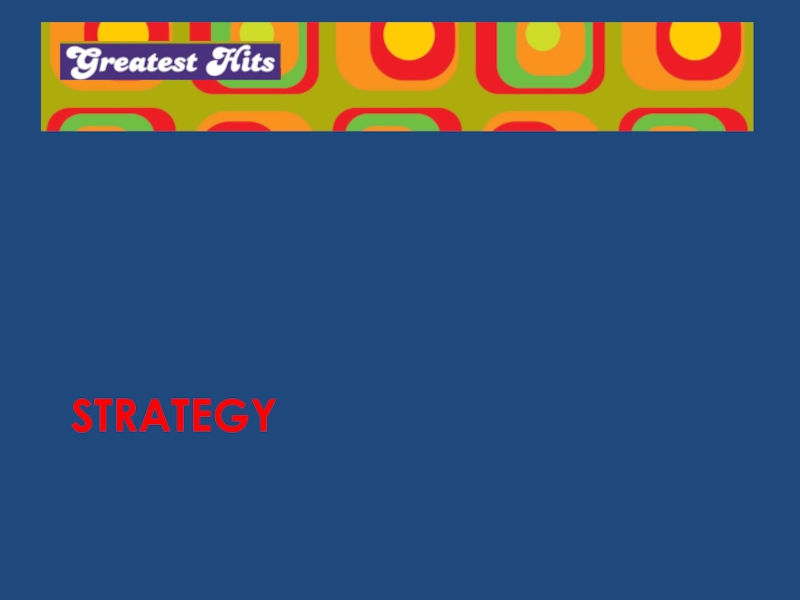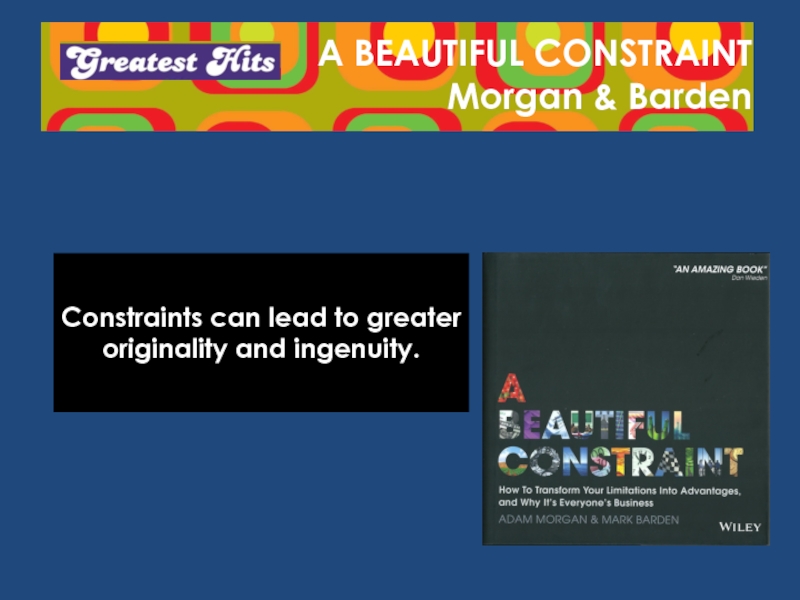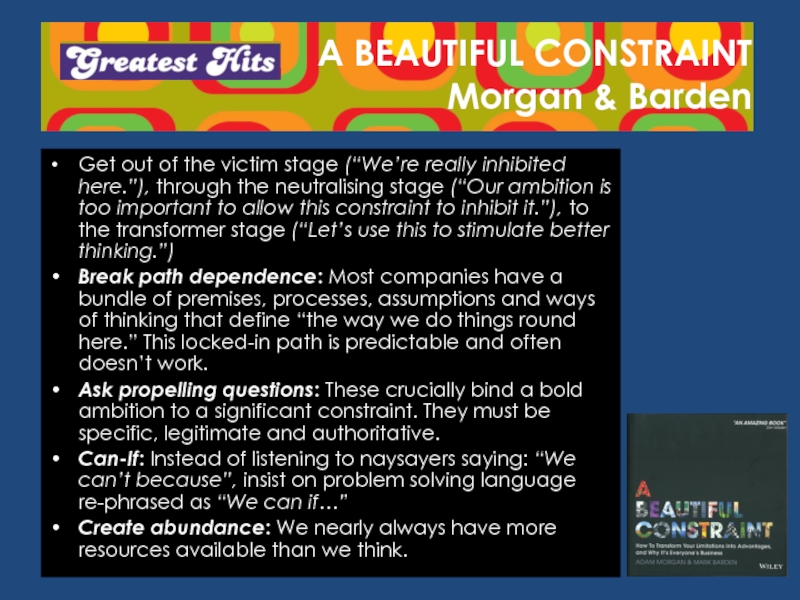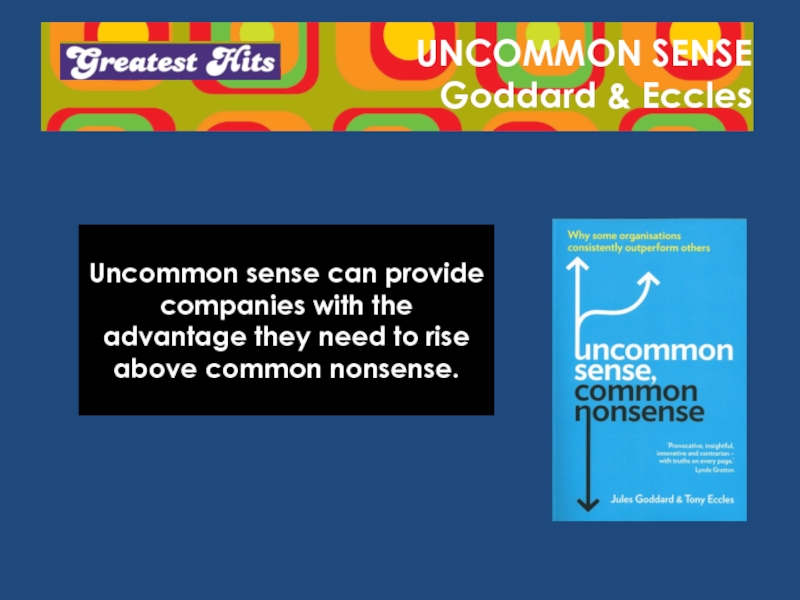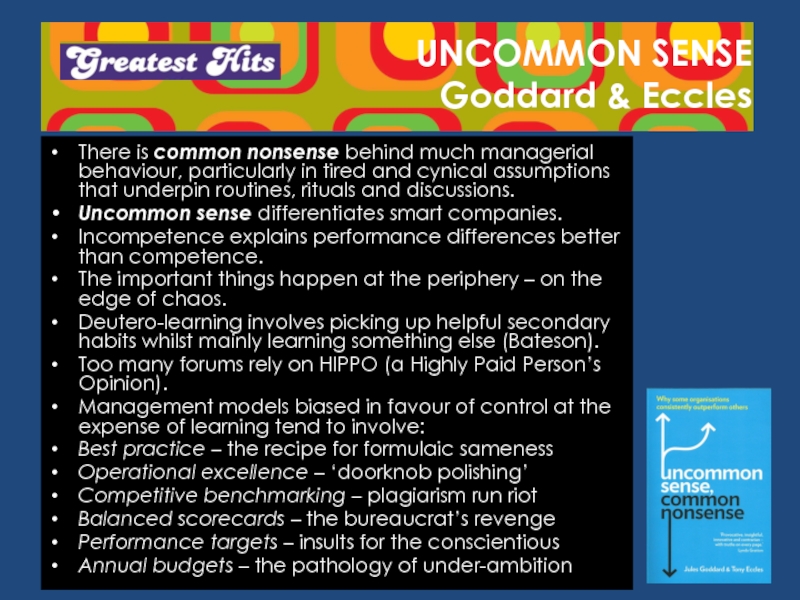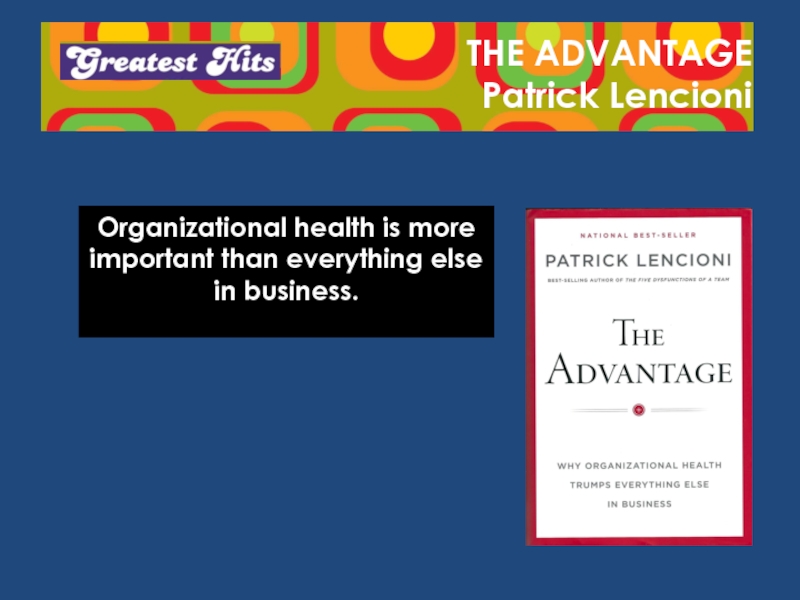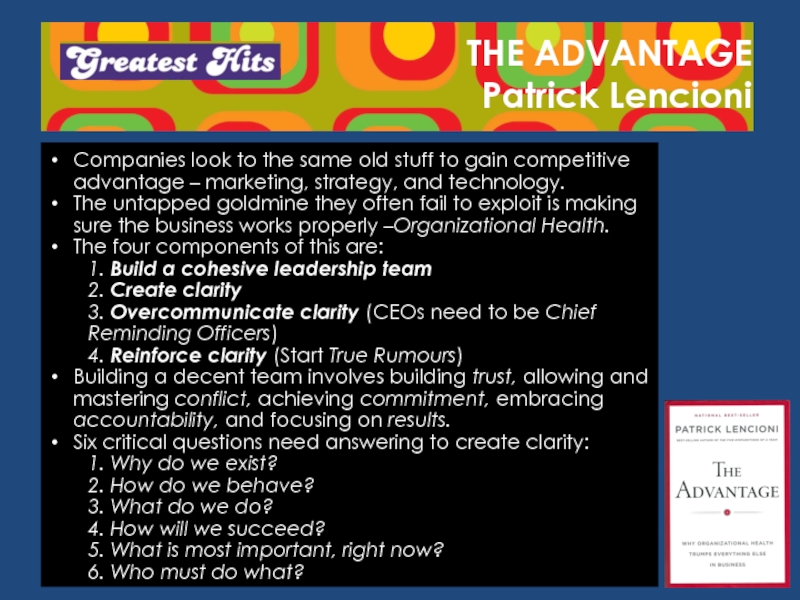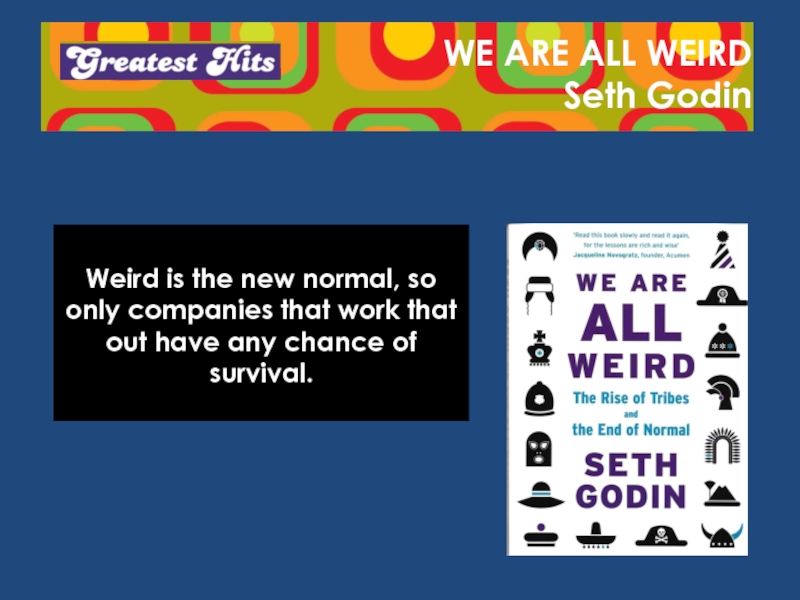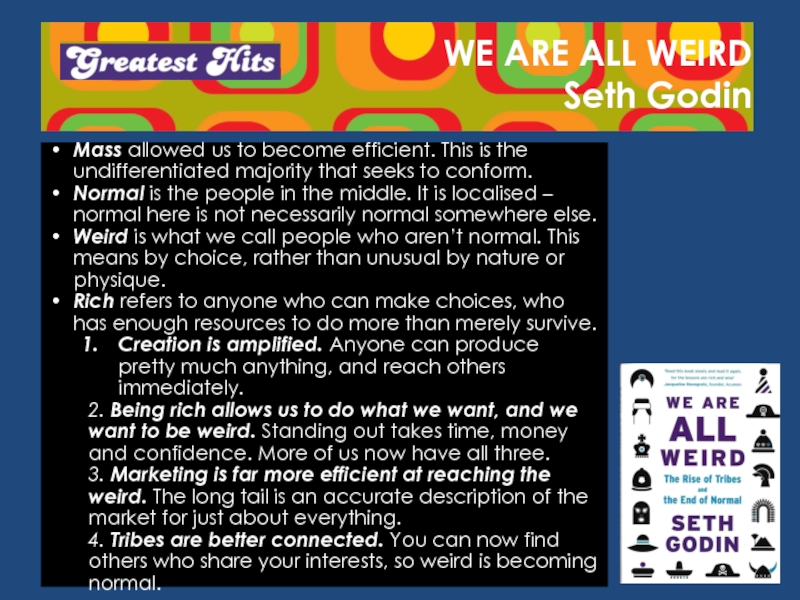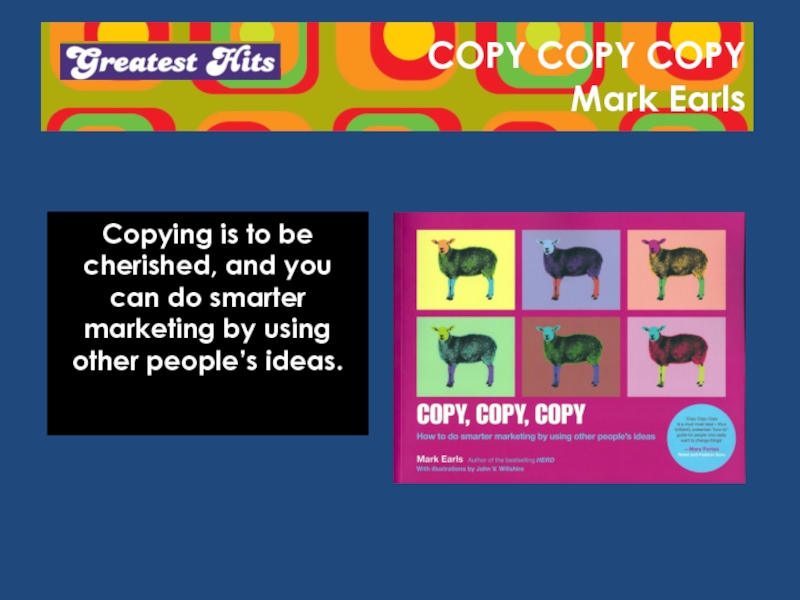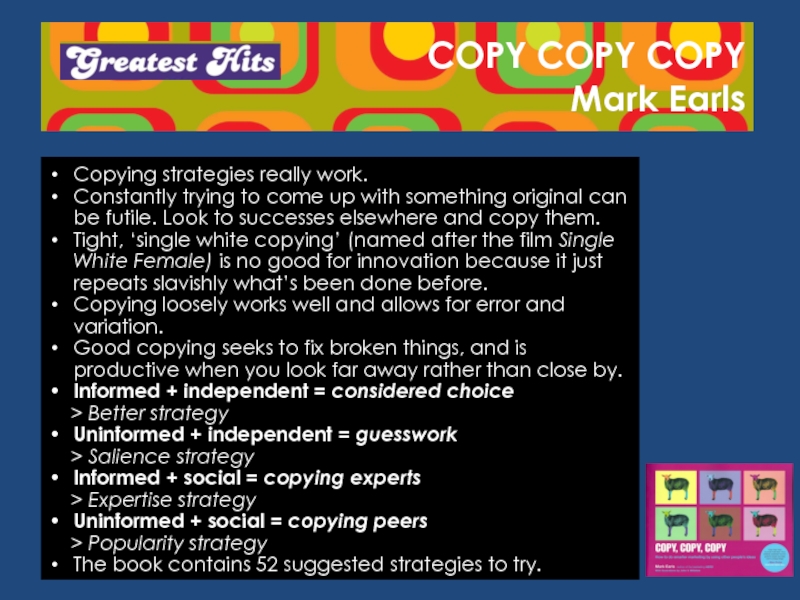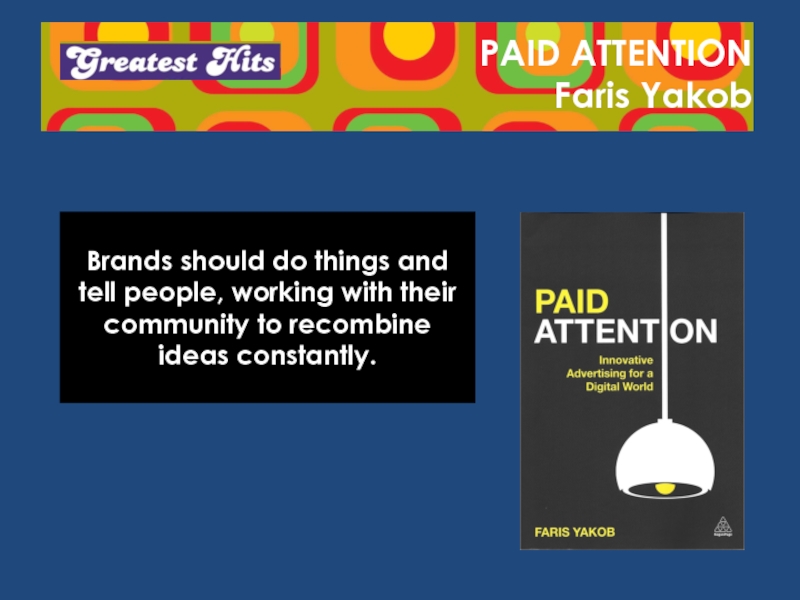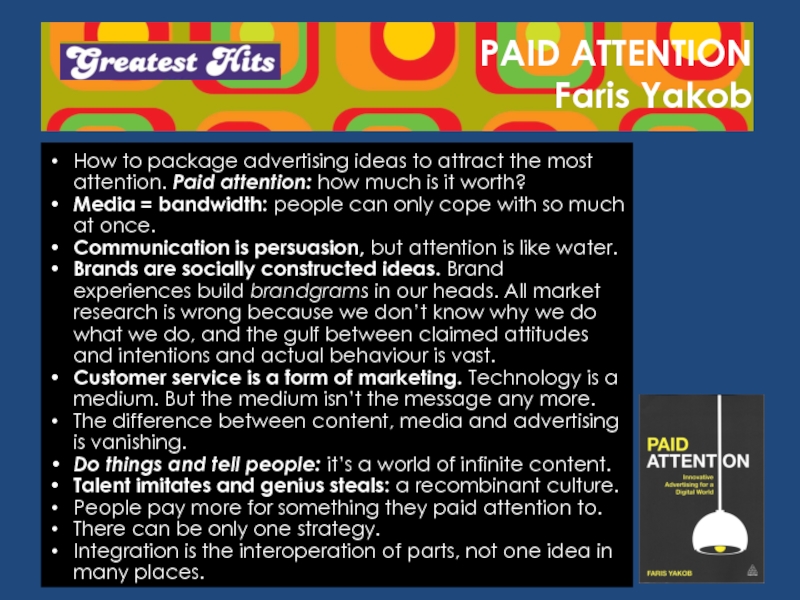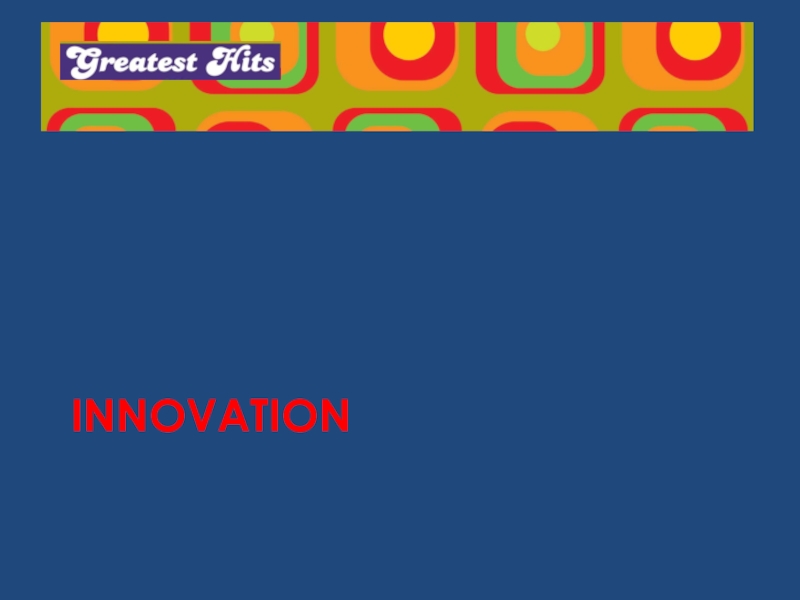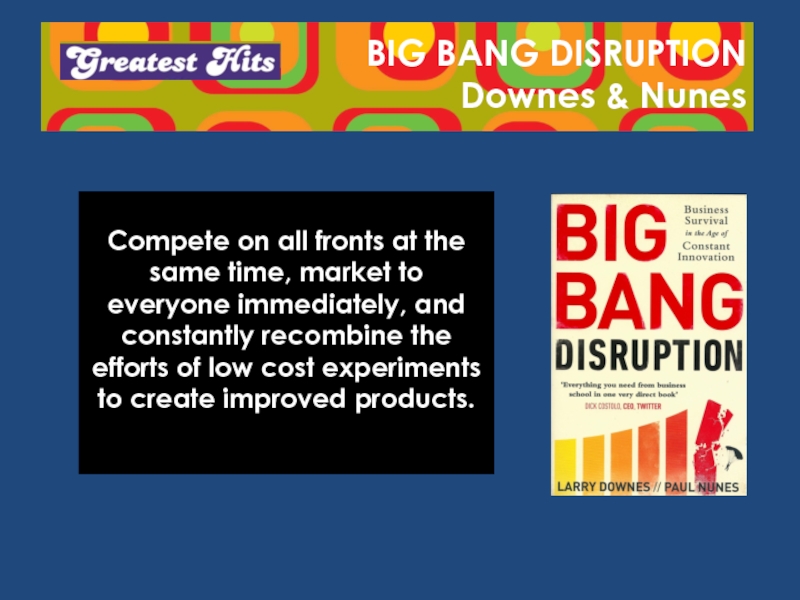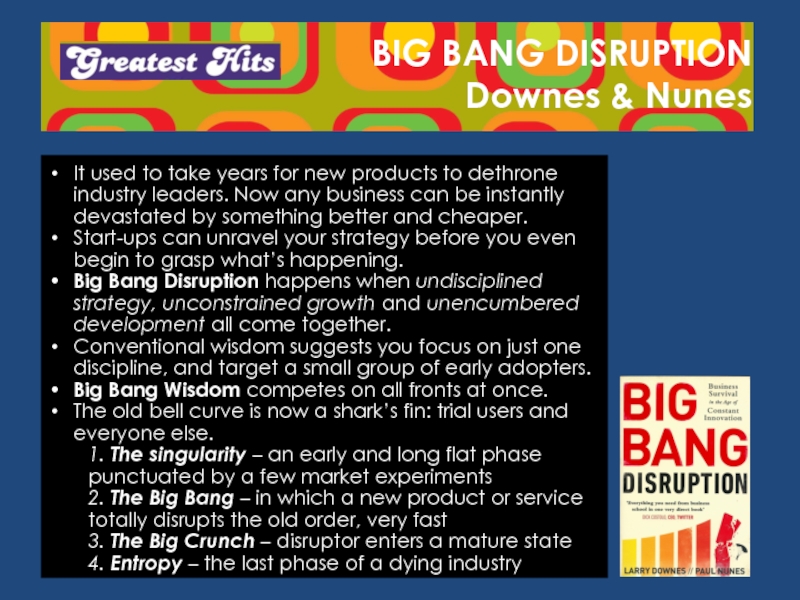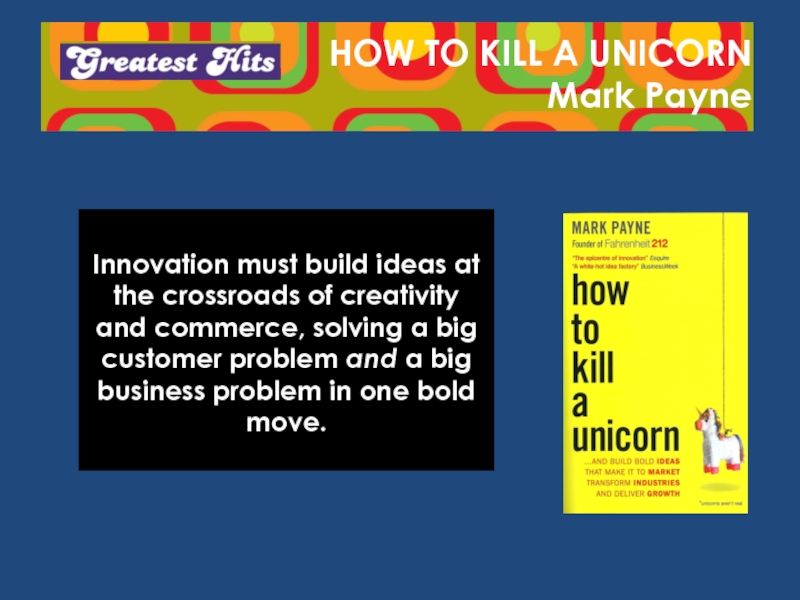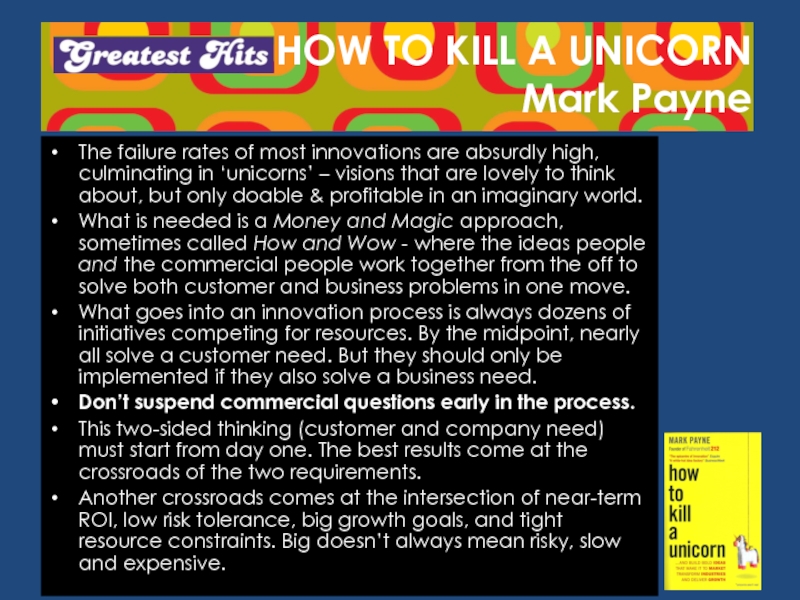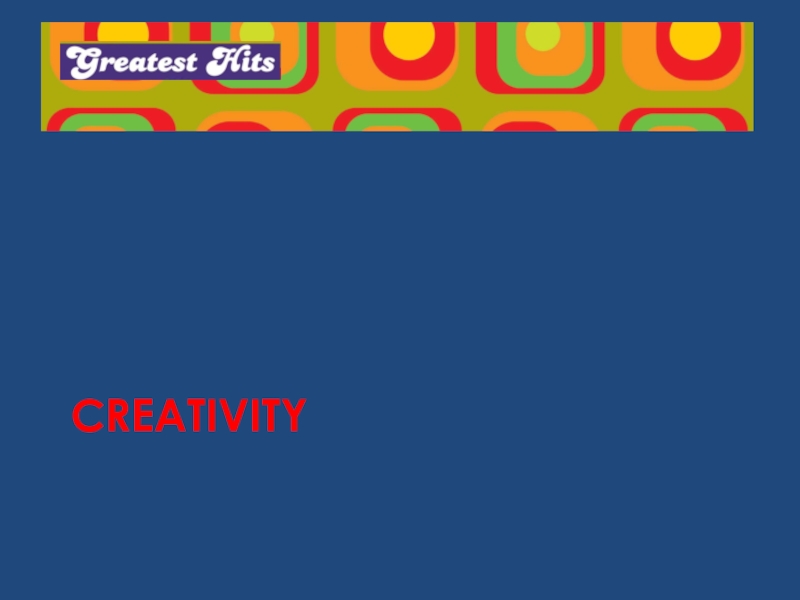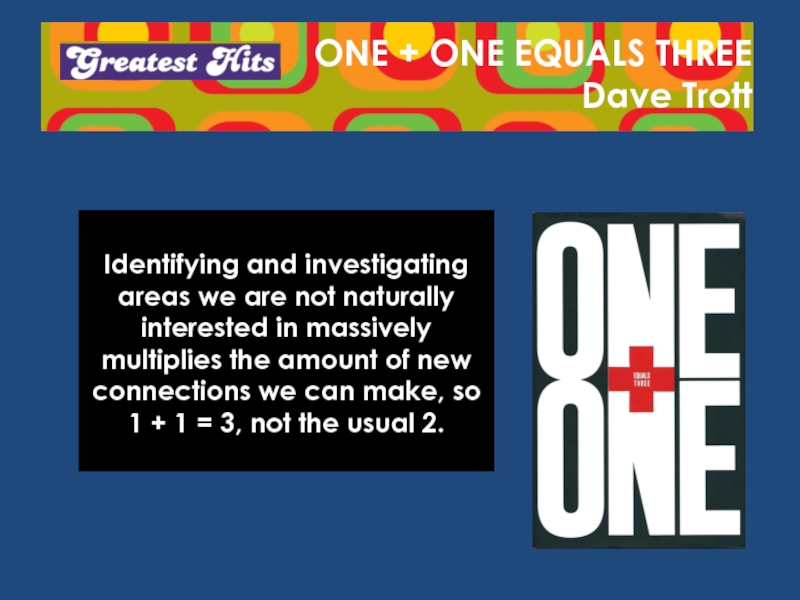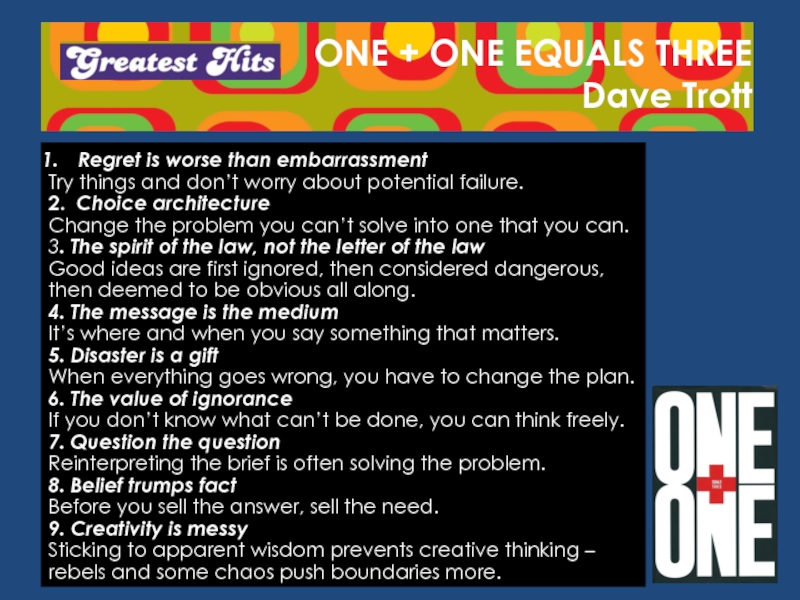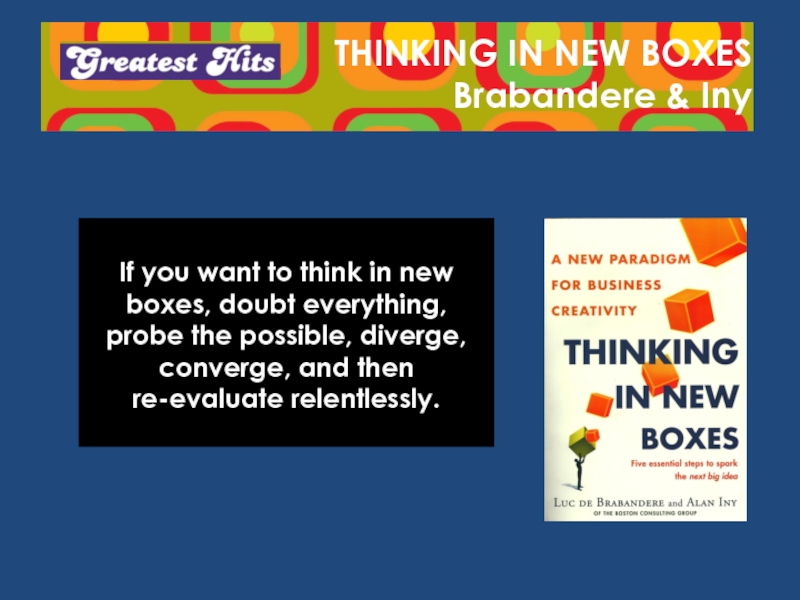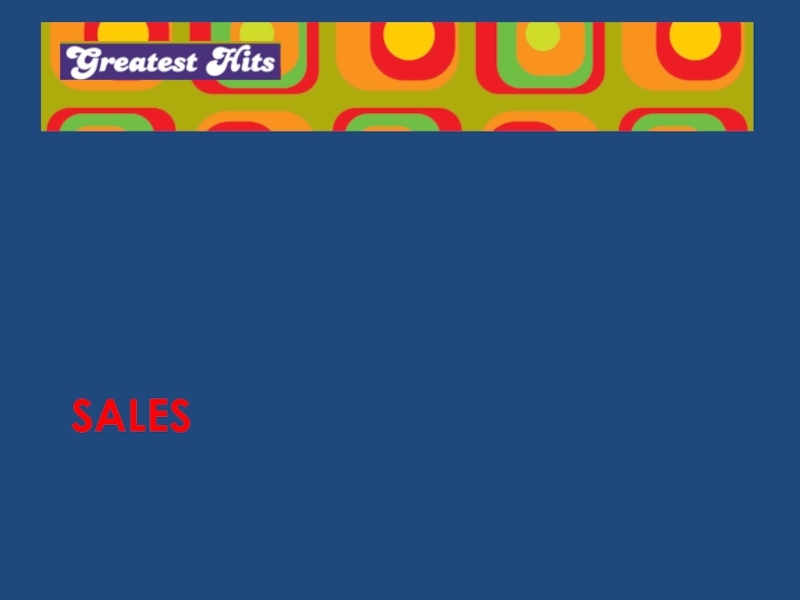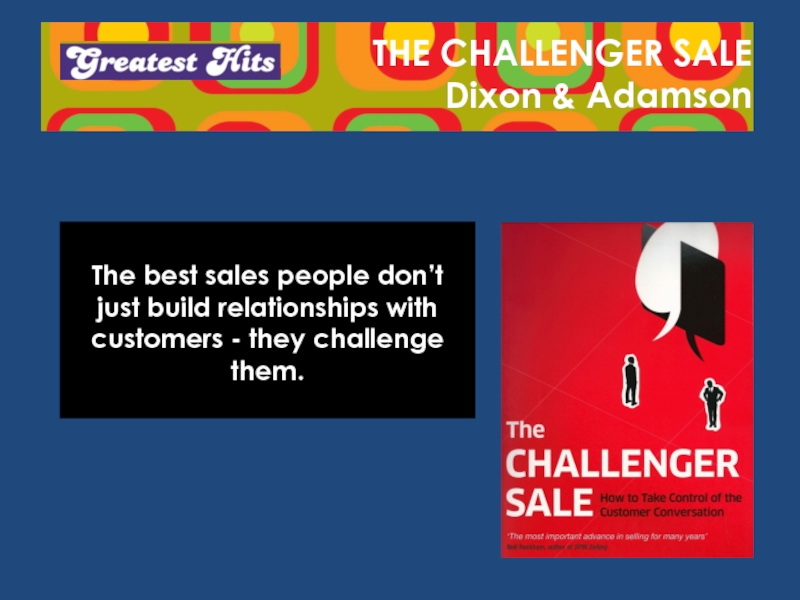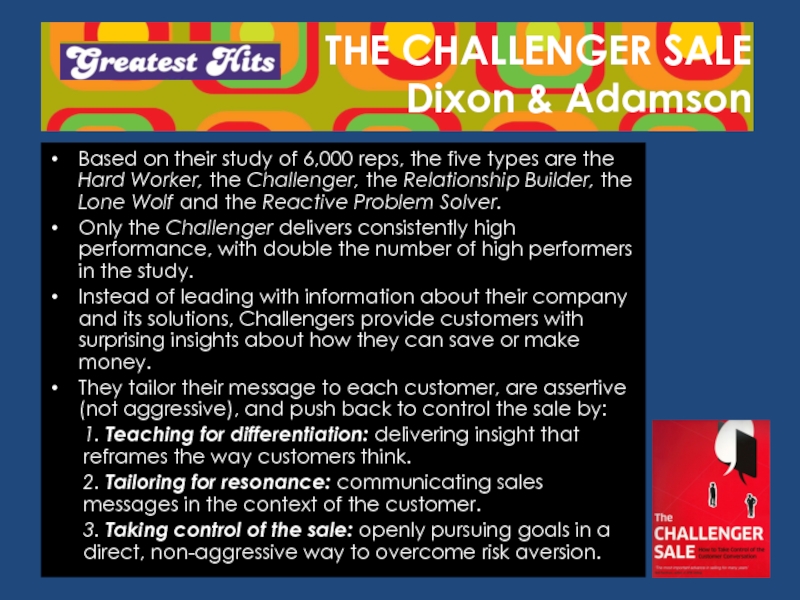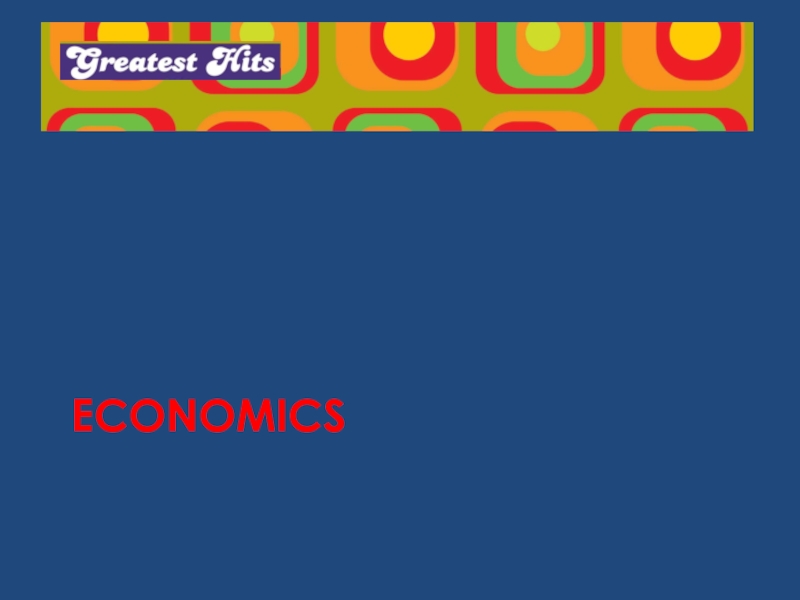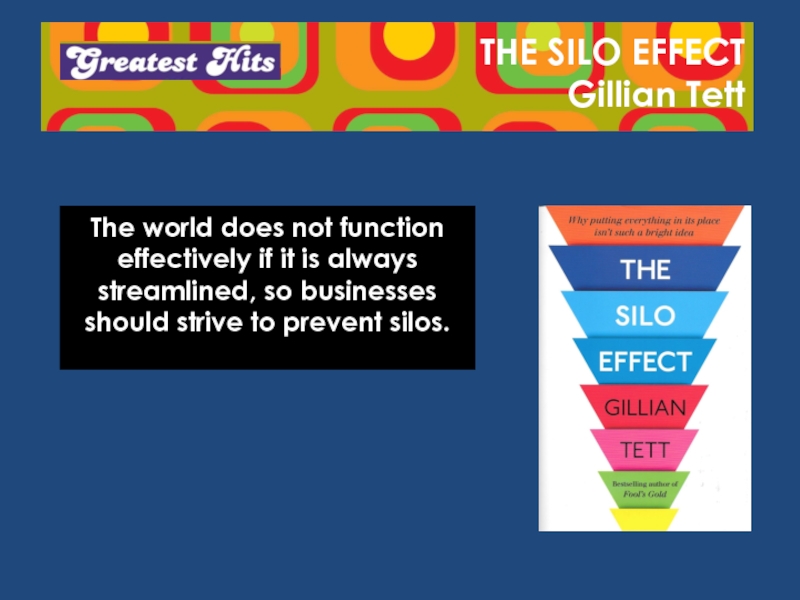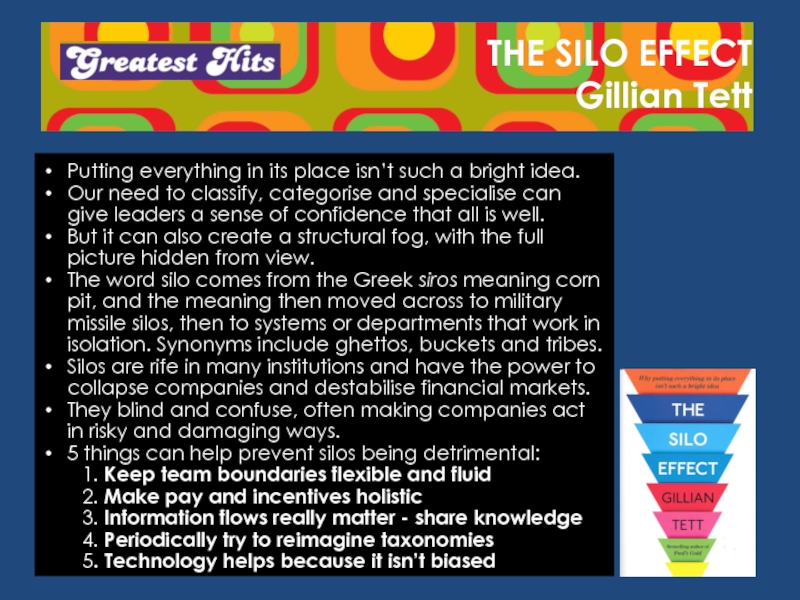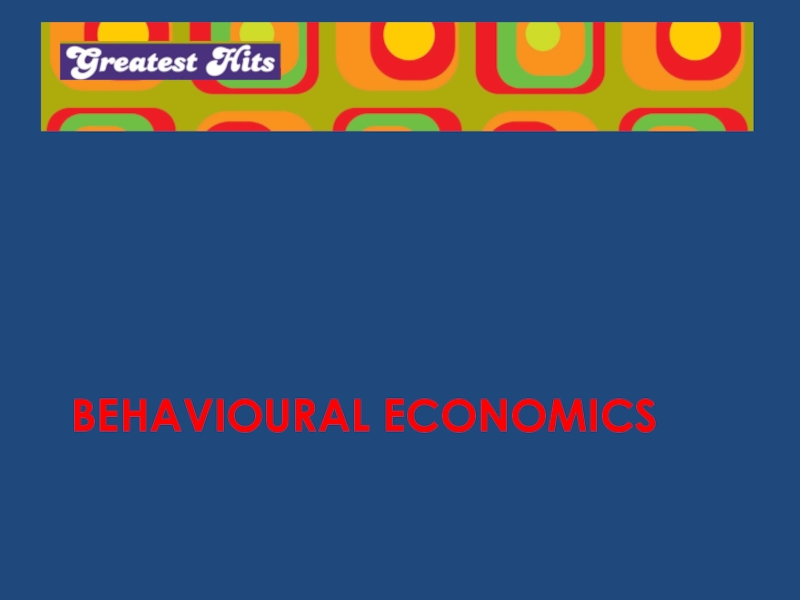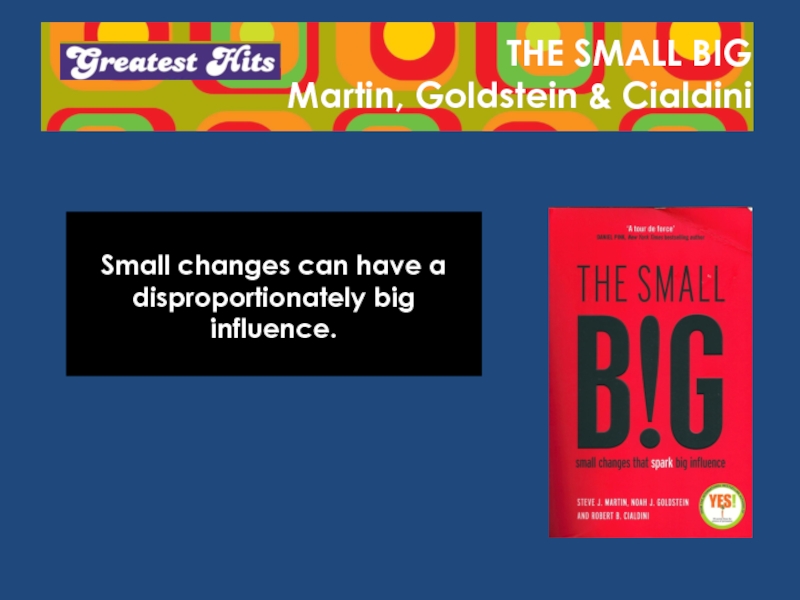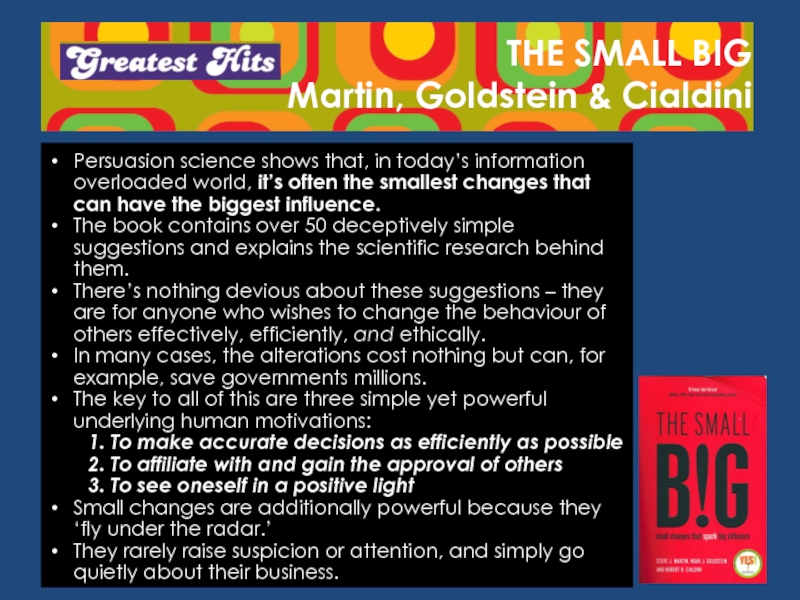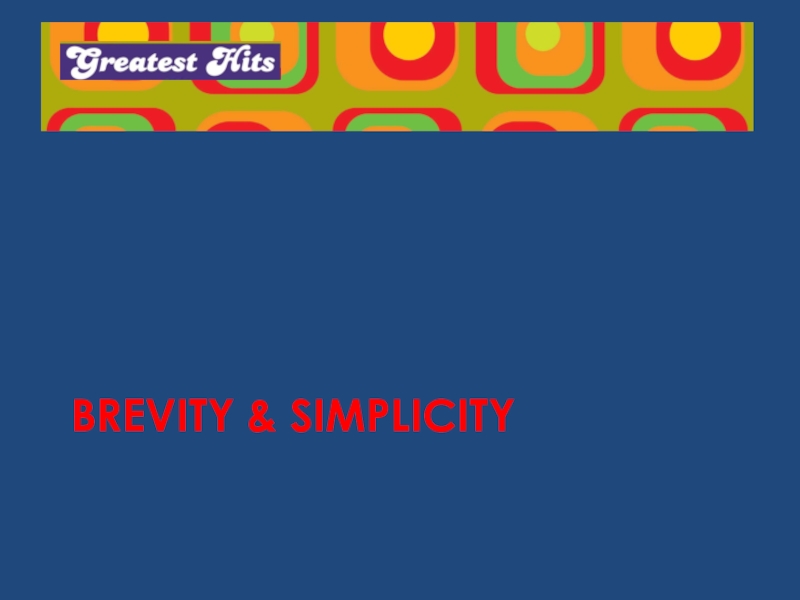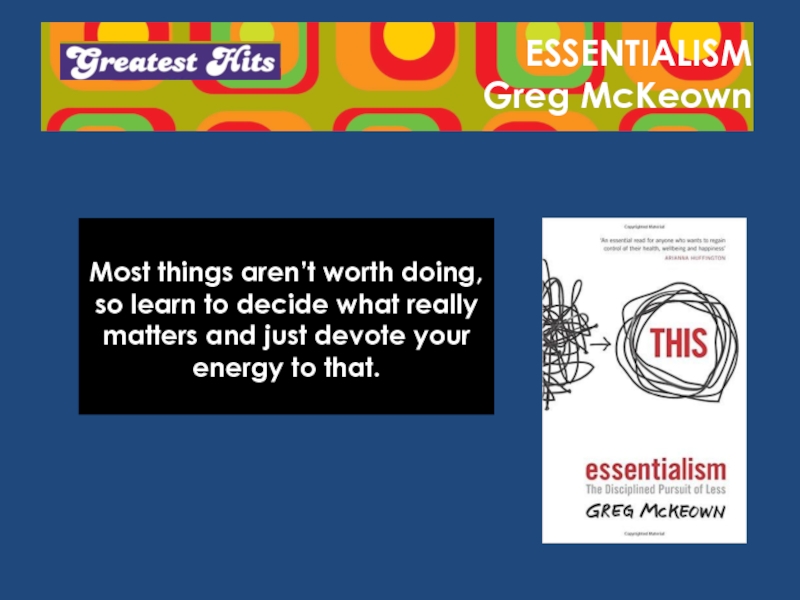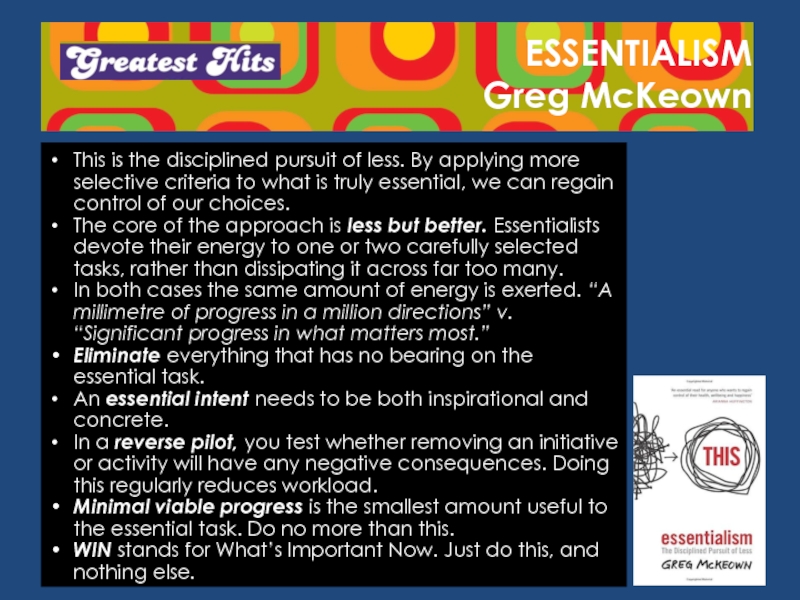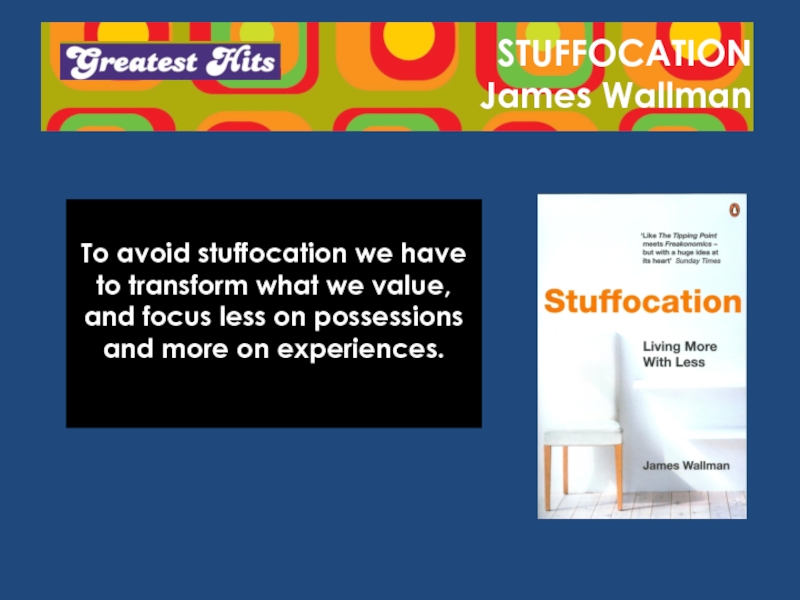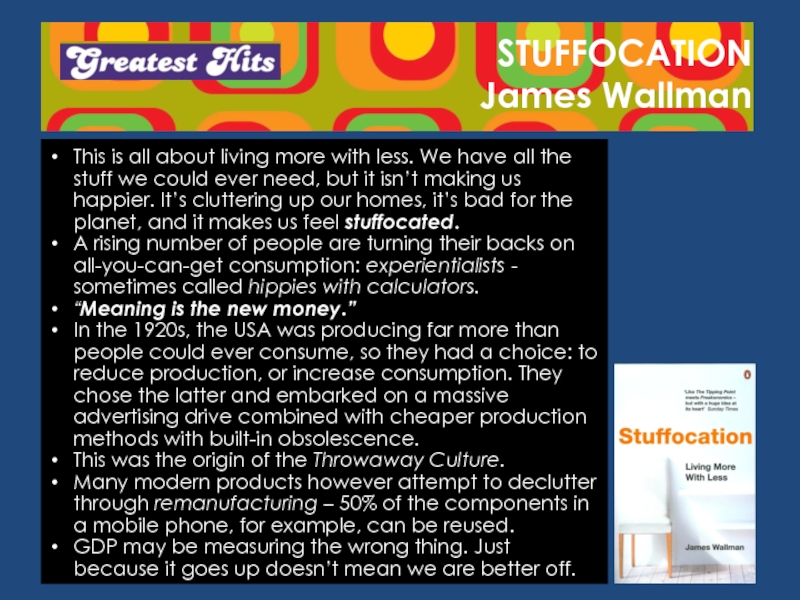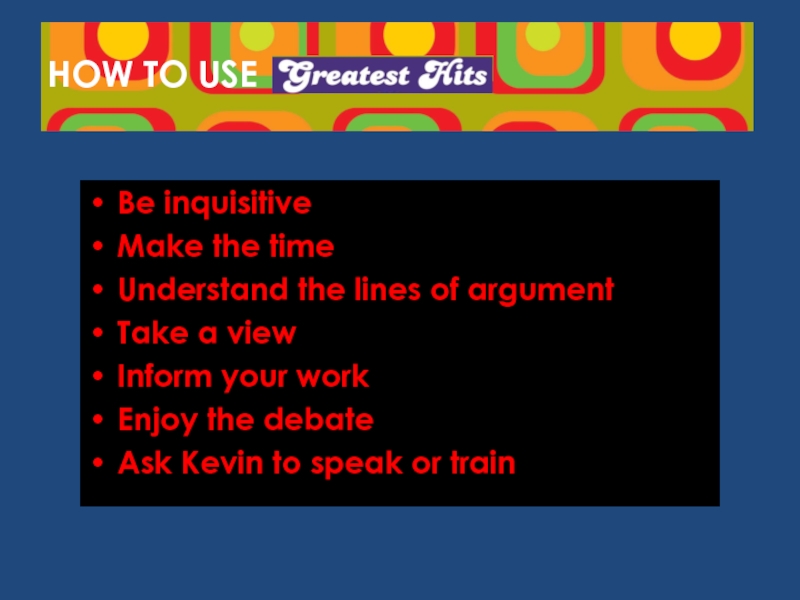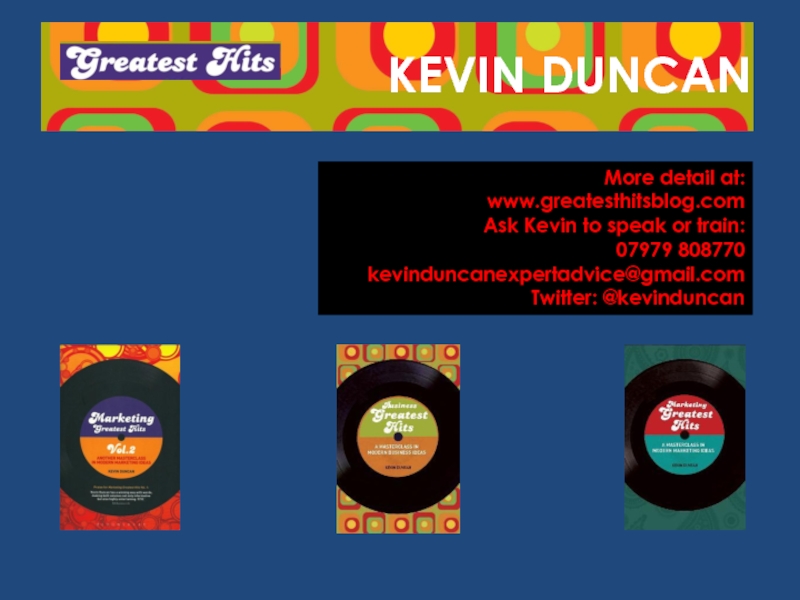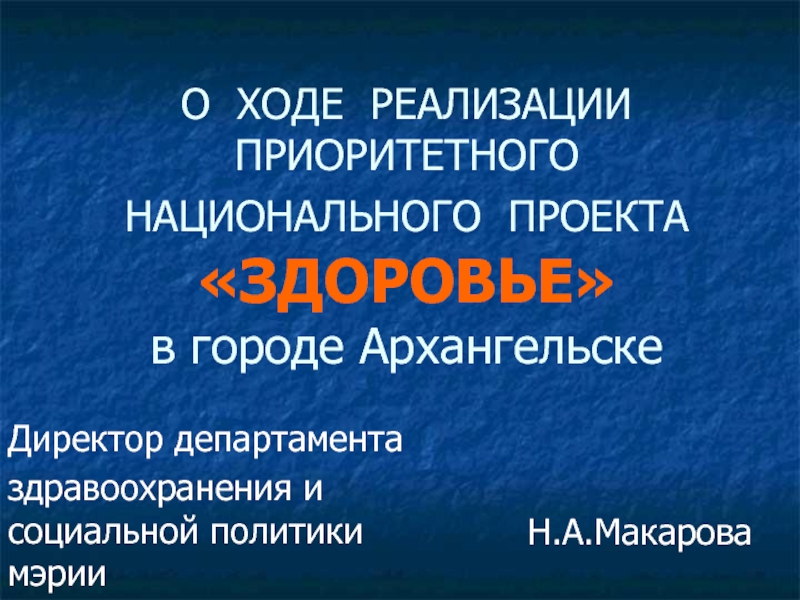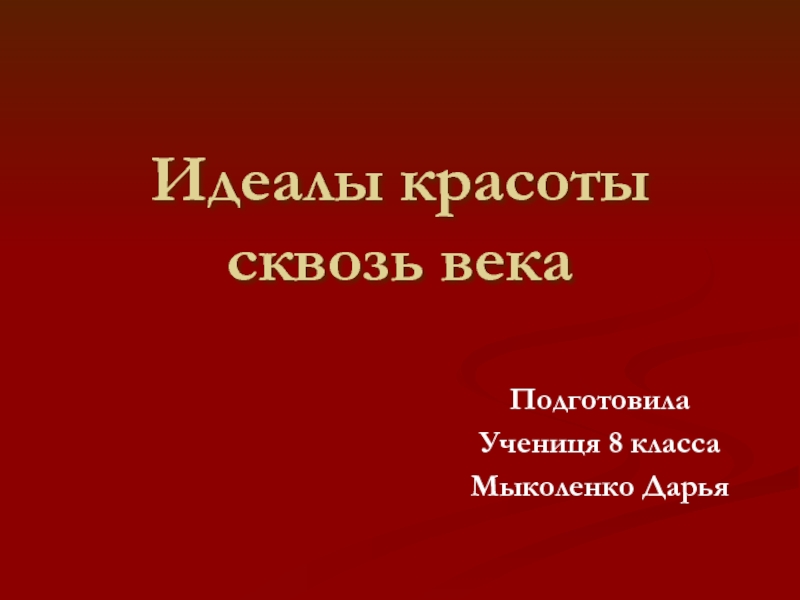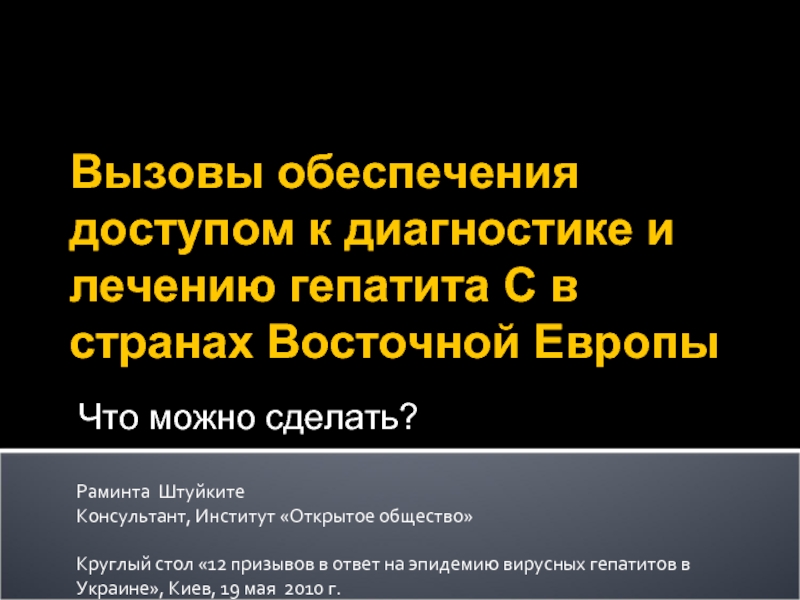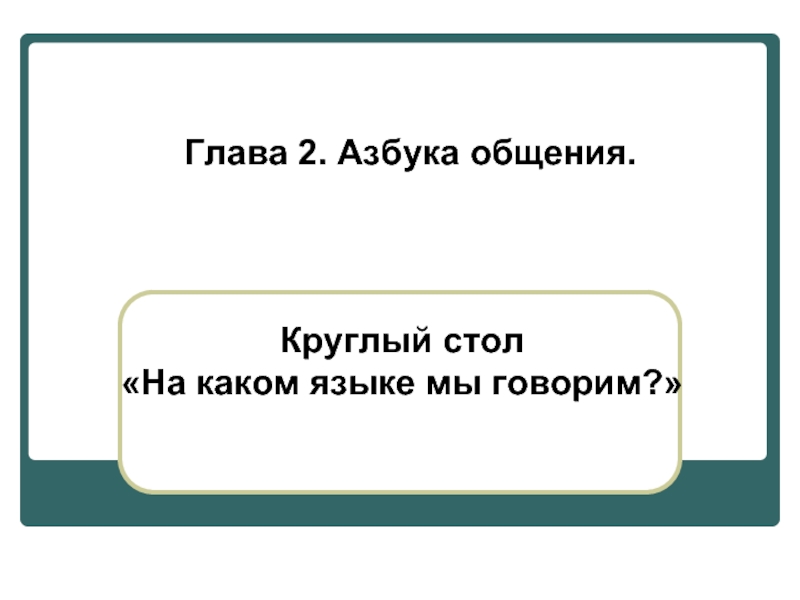- Главная
- Разное
- Дизайн
- Бизнес и предпринимательство
- Аналитика
- Образование
- Развлечения
- Красота и здоровье
- Финансы
- Государство
- Путешествия
- Спорт
- Недвижимость
- Армия
- Графика
- Культурология
- Еда и кулинария
- Лингвистика
- Английский язык
- Астрономия
- Алгебра
- Биология
- География
- Детские презентации
- Информатика
- История
- Литература
- Маркетинг
- Математика
- Медицина
- Менеджмент
- Музыка
- МХК
- Немецкий язык
- ОБЖ
- Обществознание
- Окружающий мир
- Педагогика
- Русский язык
- Технология
- Физика
- Философия
- Химия
- Шаблоны, картинки для презентаций
- Экология
- Экономика
- Юриспруденция
15 FROM 15 THE BEST BOOKS OF 2015 презентация
Содержание
- 1. 15 FROM 15 THE BEST BOOKS OF 2015
- 2. WHAT IS
- 3. STRATEGY
- 4. A BEAUTIFUL CONSTRAINT Morgan & Barden
- 5. A BEAUTIFUL CONSTRAINT Morgan & Barden
- 6. UNCOMMON SENSE Goddard & Eccles Uncommon
- 7. UNCOMMON SENSE Goddard & Eccles There
- 8. THE ADVANTAGE Patrick Lencioni Organizational health is more important than everything else in business.
- 9. THE ADVANTAGE Patrick Lencioni Companies look to
- 10. WE ARE ALL WEIRD Seth Godin
- 11. WE ARE ALL WEIRD Seth Godin Mass
- 12. COPY COPY COPY Mark Earls Copying is
- 13. COPY COPY COPY Mark Earls Copying strategies
- 14. PAID ATTENTION Faris Yakob Brands should
- 15. PAID ATTENTION Faris Yakob How to package
- 16. INNOVATION
- 17. BIG BANG DISRUPTION Downes & Nunes
- 18. BIG BANG DISRUPTION Downes & Nunes
- 19. HOW TO KILL A UNICORN Mark Payne
- 20. HOW TO KILL A UNICORN Mark Payne
- 21. CREATIVITY
- 22. ONE + ONE EQUALS THREE Dave Trott
- 23. ONE + ONE EQUALS THREE Dave Trott
- 24. THINKING IN NEW BOXES Brabandere & Iny
- 25. THINKING IN NEW BOXES Brabandere & Iny
- 26. SALES
- 27. THE CHALLENGER SALE Dixon & Adamson
- 28. THE CHALLENGER SALE Dixon & Adamson
- 29. ECONOMICS
- 30. THE SILO EFFECT Gillian Tett The world
- 31. THE SILO EFFECT Gillian Tett Putting everything
- 32. BEHAVIOURAL ECONOMICS
- 33. THE SMALL BIG Martin, Goldstein & Cialdini
- 34. THE SMALL BIG Martin, Goldstein & Cialdini
- 35. BREVITY & SIMPLICITY
- 36. ESSENTIALISM Greg McKeown Most things aren’t
- 37. ESSENTIALISM Greg McKeown This is the disciplined
- 38. STUFFOCATION James Wallman To avoid
- 39. STUFFOCATION James Wallman This is all
- 40. HOW TO USE Be inquisitive Make the
- 41. KEVIN DUNCAN More detail at: www.greatesthitsblog.com Ask
Слайд 2WHAT IS
?
A library of over 280 books
A blog
A series of printed books
iphone and ipad apps
One-page summaries
One-sentence summaries
Training programmes
Keynote speeches
A fertile source of new ideas
Слайд 4A BEAUTIFUL CONSTRAINT
Morgan & Barden
Constraints can lead to greater originality and
ingenuity.
Слайд 5A BEAUTIFUL CONSTRAINT
Morgan & Barden
Get out of the victim stage (“We’re
really inhibited here.”), through the neutralising stage (“Our ambition is too important to allow this constraint to inhibit it.”), to the transformer stage (“Let’s use this to stimulate better thinking.”)
Break path dependence: Most companies have a bundle of premises, processes, assumptions and ways of thinking that define “the way we do things round here.” This locked-in path is predictable and often doesn’t work.
Ask propelling questions: These crucially bind a bold ambition to a significant constraint. They must be specific, legitimate and authoritative.
Can-If: Instead of listening to naysayers saying: “We can’t because”, insist on problem solving language re-phrased as “We can if…”
Create abundance: We nearly always have more resources available than we think.
Break path dependence: Most companies have a bundle of premises, processes, assumptions and ways of thinking that define “the way we do things round here.” This locked-in path is predictable and often doesn’t work.
Ask propelling questions: These crucially bind a bold ambition to a significant constraint. They must be specific, legitimate and authoritative.
Can-If: Instead of listening to naysayers saying: “We can’t because”, insist on problem solving language re-phrased as “We can if…”
Create abundance: We nearly always have more resources available than we think.
Слайд 6UNCOMMON SENSE
Goddard & Eccles
Uncommon sense can provide companies with the advantage
they need to rise above common nonsense.
Слайд 7UNCOMMON SENSE
Goddard & Eccles
There is common nonsense behind much managerial behaviour,
particularly in tired and cynical assumptions that underpin routines, rituals and discussions.
Uncommon sense differentiates smart companies.
Incompetence explains performance differences better than competence.
The important things happen at the periphery – on the edge of chaos.
Deutero-learning involves picking up helpful secondary habits whilst mainly learning something else (Bateson).
Too many forums rely on HIPPO (a Highly Paid Person’s Opinion).
Management models biased in favour of control at the expense of learning tend to involve:
Best practice – the recipe for formulaic sameness
Operational excellence – ‘doorknob polishing’
Competitive benchmarking – plagiarism run riot
Balanced scorecards – the bureaucrat’s revenge
Performance targets – insults for the conscientious
Annual budgets – the pathology of under-ambition
Uncommon sense differentiates smart companies.
Incompetence explains performance differences better than competence.
The important things happen at the periphery – on the edge of chaos.
Deutero-learning involves picking up helpful secondary habits whilst mainly learning something else (Bateson).
Too many forums rely on HIPPO (a Highly Paid Person’s Opinion).
Management models biased in favour of control at the expense of learning tend to involve:
Best practice – the recipe for formulaic sameness
Operational excellence – ‘doorknob polishing’
Competitive benchmarking – plagiarism run riot
Balanced scorecards – the bureaucrat’s revenge
Performance targets – insults for the conscientious
Annual budgets – the pathology of under-ambition
Слайд 8THE ADVANTAGE
Patrick Lencioni
Organizational health is more important than everything else in
business.
Слайд 9THE ADVANTAGE
Patrick Lencioni
Companies look to the same old stuff to gain
competitive advantage – marketing, strategy, and technology.
The untapped goldmine they often fail to exploit is making sure the business works properly –Organizational Health.
The four components of this are:
1. Build a cohesive leadership team
2. Create clarity
3. Overcommunicate clarity (CEOs need to be Chief Reminding Officers)
4. Reinforce clarity (Start True Rumours)
Building a decent team involves building trust, allowing and mastering conflict, achieving commitment, embracing accountability, and focusing on results.
Six critical questions need answering to create clarity:
1. Why do we exist?
2. How do we behave?
3. What do we do?
4. How will we succeed?
5. What is most important, right now?
6. Who must do what?
The untapped goldmine they often fail to exploit is making sure the business works properly –Organizational Health.
The four components of this are:
1. Build a cohesive leadership team
2. Create clarity
3. Overcommunicate clarity (CEOs need to be Chief Reminding Officers)
4. Reinforce clarity (Start True Rumours)
Building a decent team involves building trust, allowing and mastering conflict, achieving commitment, embracing accountability, and focusing on results.
Six critical questions need answering to create clarity:
1. Why do we exist?
2. How do we behave?
3. What do we do?
4. How will we succeed?
5. What is most important, right now?
6. Who must do what?
Слайд 10WE ARE ALL WEIRD
Seth Godin
Weird is the new normal, so only
companies that work that out have any chance of survival.
Слайд 11WE ARE ALL WEIRD
Seth Godin
Mass allowed us to become efficient. This
is the undifferentiated majority that seeks to conform.
Normal is the people in the middle. It is localised – normal here is not necessarily normal somewhere else.
Weird is what we call people who aren’t normal. This means by choice, rather than unusual by nature or physique.
Rich refers to anyone who can make choices, who has enough resources to do more than merely survive.
Creation is amplified. Anyone can produce pretty much anything, and reach others immediately.
2. Being rich allows us to do what we want, and we want to be weird. Standing out takes time, money and confidence. More of us now have all three.
3. Marketing is far more efficient at reaching the weird. The long tail is an accurate description of the market for just about everything.
4. Tribes are better connected. You can now find others who share your interests, so weird is becoming normal.
Normal is the people in the middle. It is localised – normal here is not necessarily normal somewhere else.
Weird is what we call people who aren’t normal. This means by choice, rather than unusual by nature or physique.
Rich refers to anyone who can make choices, who has enough resources to do more than merely survive.
Creation is amplified. Anyone can produce pretty much anything, and reach others immediately.
2. Being rich allows us to do what we want, and we want to be weird. Standing out takes time, money and confidence. More of us now have all three.
3. Marketing is far more efficient at reaching the weird. The long tail is an accurate description of the market for just about everything.
4. Tribes are better connected. You can now find others who share your interests, so weird is becoming normal.
Слайд 12COPY COPY COPY
Mark Earls
Copying is to be cherished, and you can
do smarter marketing by using other people’s ideas.
Слайд 13COPY COPY COPY
Mark Earls
Copying strategies really work.
Constantly trying to come up
with something original can be futile. Look to successes elsewhere and copy them.
Tight, ‘single white copying’ (named after the film Single White Female) is no good for innovation because it just repeats slavishly what’s been done before.
Copying loosely works well and allows for error and variation.
Good copying seeks to fix broken things, and is productive when you look far away rather than close by.
Informed + independent = considered choice
> Better strategy
Uninformed + independent = guesswork
> Salience strategy
Informed + social = copying experts
> Expertise strategy
Uninformed + social = copying peers
> Popularity strategy
The book contains 52 suggested strategies to try.
Tight, ‘single white copying’ (named after the film Single White Female) is no good for innovation because it just repeats slavishly what’s been done before.
Copying loosely works well and allows for error and variation.
Good copying seeks to fix broken things, and is productive when you look far away rather than close by.
Informed + independent = considered choice
> Better strategy
Uninformed + independent = guesswork
> Salience strategy
Informed + social = copying experts
> Expertise strategy
Uninformed + social = copying peers
> Popularity strategy
The book contains 52 suggested strategies to try.
Слайд 14PAID ATTENTION
Faris Yakob
Brands should do things and tell people, working with
their community to recombine ideas constantly.
Слайд 15PAID ATTENTION
Faris Yakob
How to package advertising ideas to attract the most
attention. Paid attention: how much is it worth?
Media = bandwidth: people can only cope with so much at once.
Communication is persuasion, but attention is like water.
Brands are socially constructed ideas. Brand experiences build brandgrams in our heads. All market research is wrong because we don’t know why we do what we do, and the gulf between claimed attitudes and intentions and actual behaviour is vast.
Customer service is a form of marketing. Technology is a medium. But the medium isn’t the message any more.
The difference between content, media and advertising is vanishing.
Do things and tell people: it’s a world of infinite content.
Talent imitates and genius steals: a recombinant culture.
People pay more for something they paid attention to.
There can be only one strategy.
Integration is the interoperation of parts, not one idea in many places.
Media = bandwidth: people can only cope with so much at once.
Communication is persuasion, but attention is like water.
Brands are socially constructed ideas. Brand experiences build brandgrams in our heads. All market research is wrong because we don’t know why we do what we do, and the gulf between claimed attitudes and intentions and actual behaviour is vast.
Customer service is a form of marketing. Technology is a medium. But the medium isn’t the message any more.
The difference between content, media and advertising is vanishing.
Do things and tell people: it’s a world of infinite content.
Talent imitates and genius steals: a recombinant culture.
People pay more for something they paid attention to.
There can be only one strategy.
Integration is the interoperation of parts, not one idea in many places.
Слайд 17BIG BANG DISRUPTION
Downes & Nunes
Compete on all fronts at the same
time, market to everyone immediately, and constantly recombine the efforts of low cost experiments to create improved products.
Слайд 18BIG BANG DISRUPTION
Downes & Nunes
It used to take years for new
products to dethrone industry leaders. Now any business can be instantly devastated by something better and cheaper.
Start-ups can unravel your strategy before you even begin to grasp what’s happening.
Big Bang Disruption happens when undisciplined strategy, unconstrained growth and unencumbered development all come together.
Conventional wisdom suggests you focus on just one discipline, and target a small group of early adopters.
Big Bang Wisdom competes on all fronts at once.
The old bell curve is now a shark’s fin: trial users and everyone else.
1. The singularity – an early and long flat phase punctuated by a few market experiments
2. The Big Bang – in which a new product or service totally disrupts the old order, very fast
3. The Big Crunch – disruptor enters a mature state
4. Entropy – the last phase of a dying industry
Start-ups can unravel your strategy before you even begin to grasp what’s happening.
Big Bang Disruption happens when undisciplined strategy, unconstrained growth and unencumbered development all come together.
Conventional wisdom suggests you focus on just one discipline, and target a small group of early adopters.
Big Bang Wisdom competes on all fronts at once.
The old bell curve is now a shark’s fin: trial users and everyone else.
1. The singularity – an early and long flat phase punctuated by a few market experiments
2. The Big Bang – in which a new product or service totally disrupts the old order, very fast
3. The Big Crunch – disruptor enters a mature state
4. Entropy – the last phase of a dying industry
Слайд 19HOW TO KILL A UNICORN
Mark Payne
Innovation must build ideas at the
crossroads of creativity and commerce, solving a big customer problem and a big business problem in one bold move.
Слайд 20HOW TO KILL A UNICORN
Mark Payne
The failure rates of most innovations
are absurdly high, culminating in ‘unicorns’ – visions that are lovely to think about, but only doable & profitable in an imaginary world.
What is needed is a Money and Magic approach, sometimes called How and Wow - where the ideas people and the commercial people work together from the off to solve both customer and business problems in one move.
What goes into an innovation process is always dozens of initiatives competing for resources. By the midpoint, nearly all solve a customer need. But they should only be implemented if they also solve a business need.
Don’t suspend commercial questions early in the process.
This two-sided thinking (customer and company need) must start from day one. The best results come at the crossroads of the two requirements.
Another crossroads comes at the intersection of near-term ROI, low risk tolerance, big growth goals, and tight resource constraints. Big doesn’t always mean risky, slow and expensive.
What is needed is a Money and Magic approach, sometimes called How and Wow - where the ideas people and the commercial people work together from the off to solve both customer and business problems in one move.
What goes into an innovation process is always dozens of initiatives competing for resources. By the midpoint, nearly all solve a customer need. But they should only be implemented if they also solve a business need.
Don’t suspend commercial questions early in the process.
This two-sided thinking (customer and company need) must start from day one. The best results come at the crossroads of the two requirements.
Another crossroads comes at the intersection of near-term ROI, low risk tolerance, big growth goals, and tight resource constraints. Big doesn’t always mean risky, slow and expensive.
Слайд 22ONE + ONE EQUALS THREE
Dave Trott
Identifying and investigating areas we are
not naturally interested in massively multiplies the amount of new connections we can make, so 1 + 1 = 3, not the usual 2.
Слайд 23ONE + ONE EQUALS THREE
Dave Trott
Regret is worse than embarrassment
Try things
and don’t worry about potential failure.
2. Choice architecture
Change the problem you can’t solve into one that you can.
3. The spirit of the law, not the letter of the law
Good ideas are first ignored, then considered dangerous, then deemed to be obvious all along.
4. The message is the medium
It’s where and when you say something that matters.
5. Disaster is a gift
When everything goes wrong, you have to change the plan.
6. The value of ignorance
If you don’t know what can’t be done, you can think freely.
7. Question the question
Reinterpreting the brief is often solving the problem.
8. Belief trumps fact
Before you sell the answer, sell the need.
9. Creativity is messy
Sticking to apparent wisdom prevents creative thinking – rebels and some chaos push boundaries more.
2. Choice architecture
Change the problem you can’t solve into one that you can.
3. The spirit of the law, not the letter of the law
Good ideas are first ignored, then considered dangerous, then deemed to be obvious all along.
4. The message is the medium
It’s where and when you say something that matters.
5. Disaster is a gift
When everything goes wrong, you have to change the plan.
6. The value of ignorance
If you don’t know what can’t be done, you can think freely.
7. Question the question
Reinterpreting the brief is often solving the problem.
8. Belief trumps fact
Before you sell the answer, sell the need.
9. Creativity is messy
Sticking to apparent wisdom prevents creative thinking – rebels and some chaos push boundaries more.
Слайд 24THINKING IN NEW BOXES
Brabandere & Iny
If you want to think in
new boxes, doubt everything, probe the possible, diverge, converge, and then re-evaluate relentlessly.
Слайд 25THINKING IN NEW BOXES
Brabandere & Iny
Thinking ‘outside the box’ isn’t the
answer. True ingenuity needs structure, hard analysis, and bold brainstorming.
That means thinking in new boxes. A box is a mental model – a construction that exists purely within you, and which dictates how you view the world.
Inductive thinking involves moving from observed fragmented details to a connected view, a binding principle, hypothesis, or box.
Deductive thinking involves applying such a framework to observed details to see if the box has the capacity to interpret them. Logic is the science of deduction.
A Eureka moment is when you suddenly realise how to shift your perception.
A Caramba moment is when you realise one or more of your boxes (set of assumptions) are out of date.
Re-examine your approach to business creativity:
1. Doubt everything. 2. Probe the possible.
3. Diverge. 4. Converge. 5. Re-evaluate relentlessly.
That means thinking in new boxes. A box is a mental model – a construction that exists purely within you, and which dictates how you view the world.
Inductive thinking involves moving from observed fragmented details to a connected view, a binding principle, hypothesis, or box.
Deductive thinking involves applying such a framework to observed details to see if the box has the capacity to interpret them. Logic is the science of deduction.
A Eureka moment is when you suddenly realise how to shift your perception.
A Caramba moment is when you realise one or more of your boxes (set of assumptions) are out of date.
Re-examine your approach to business creativity:
1. Doubt everything. 2. Probe the possible.
3. Diverge. 4. Converge. 5. Re-evaluate relentlessly.
Слайд 27THE CHALLENGER SALE
Dixon & Adamson
The best sales people don’t just build
relationships with customers - they challenge them.
Слайд 28THE CHALLENGER SALE
Dixon & Adamson
Based on their study of 6,000 reps,
the five types are the Hard Worker, the Challenger, the Relationship Builder, the Lone Wolf and the Reactive Problem Solver.
Only the Challenger delivers consistently high performance, with double the number of high performers in the study.
Instead of leading with information about their company and its solutions, Challengers provide customers with surprising insights about how they can save or make money.
They tailor their message to each customer, are assertive (not aggressive), and push back to control the sale by:
1. Teaching for differentiation: delivering insight that reframes the way customers think.
2. Tailoring for resonance: communicating sales messages in the context of the customer.
3. Taking control of the sale: openly pursuing goals in a direct, non-aggressive way to overcome risk aversion.
Only the Challenger delivers consistently high performance, with double the number of high performers in the study.
Instead of leading with information about their company and its solutions, Challengers provide customers with surprising insights about how they can save or make money.
They tailor their message to each customer, are assertive (not aggressive), and push back to control the sale by:
1. Teaching for differentiation: delivering insight that reframes the way customers think.
2. Tailoring for resonance: communicating sales messages in the context of the customer.
3. Taking control of the sale: openly pursuing goals in a direct, non-aggressive way to overcome risk aversion.
Слайд 30THE SILO EFFECT
Gillian Tett
The world does not function effectively if it
is always streamlined, so businesses should strive to prevent silos.
Слайд 31THE SILO EFFECT
Gillian Tett
Putting everything in its place isn’t such a
bright idea.
Our need to classify, categorise and specialise can give leaders a sense of confidence that all is well.
But it can also create a structural fog, with the full picture hidden from view.
The word silo comes from the Greek siros meaning corn pit, and the meaning then moved across to military missile silos, then to systems or departments that work in isolation. Synonyms include ghettos, buckets and tribes.
Silos are rife in many institutions and have the power to collapse companies and destabilise financial markets.
They blind and confuse, often making companies act in risky and damaging ways.
5 things can help prevent silos being detrimental:
1. Keep team boundaries flexible and fluid
2. Make pay and incentives holistic
3. Information flows really matter - share knowledge
4. Periodically try to reimagine taxonomies
5. Technology helps because it isn’t biased
Our need to classify, categorise and specialise can give leaders a sense of confidence that all is well.
But it can also create a structural fog, with the full picture hidden from view.
The word silo comes from the Greek siros meaning corn pit, and the meaning then moved across to military missile silos, then to systems or departments that work in isolation. Synonyms include ghettos, buckets and tribes.
Silos are rife in many institutions and have the power to collapse companies and destabilise financial markets.
They blind and confuse, often making companies act in risky and damaging ways.
5 things can help prevent silos being detrimental:
1. Keep team boundaries flexible and fluid
2. Make pay and incentives holistic
3. Information flows really matter - share knowledge
4. Periodically try to reimagine taxonomies
5. Technology helps because it isn’t biased
Слайд 33THE SMALL BIG
Martin, Goldstein & Cialdini
Small changes can have a disproportionately
big influence.
Слайд 34THE SMALL BIG
Martin, Goldstein & Cialdini
Persuasion science shows that, in today’s
information overloaded world, it’s often the smallest changes that can have the biggest influence.
The book contains over 50 deceptively simple suggestions and explains the scientific research behind them.
There’s nothing devious about these suggestions – they are for anyone who wishes to change the behaviour of others effectively, efficiently, and ethically.
In many cases, the alterations cost nothing but can, for example, save governments millions.
The key to all of this are three simple yet powerful underlying human motivations:
1. To make accurate decisions as efficiently as possible
2. To affiliate with and gain the approval of others
3. To see oneself in a positive light
Small changes are additionally powerful because they ‘fly under the radar.’
They rarely raise suspicion or attention, and simply go quietly about their business.
The book contains over 50 deceptively simple suggestions and explains the scientific research behind them.
There’s nothing devious about these suggestions – they are for anyone who wishes to change the behaviour of others effectively, efficiently, and ethically.
In many cases, the alterations cost nothing but can, for example, save governments millions.
The key to all of this are three simple yet powerful underlying human motivations:
1. To make accurate decisions as efficiently as possible
2. To affiliate with and gain the approval of others
3. To see oneself in a positive light
Small changes are additionally powerful because they ‘fly under the radar.’
They rarely raise suspicion or attention, and simply go quietly about their business.
Слайд 36ESSENTIALISM
Greg McKeown
Most things aren’t worth doing, so learn to decide what
really matters and just devote your energy to that.
Слайд 37ESSENTIALISM
Greg McKeown
This is the disciplined pursuit of less. By applying more
selective criteria to what is truly essential, we can regain control of our choices.
The core of the approach is less but better. Essentialists devote their energy to one or two carefully selected tasks, rather than dissipating it across far too many.
In both cases the same amount of energy is exerted. “A millimetre of progress in a million directions” v. “Significant progress in what matters most.”
Eliminate everything that has no bearing on the essential task.
An essential intent needs to be both inspirational and concrete.
In a reverse pilot, you test whether removing an initiative or activity will have any negative consequences. Doing this regularly reduces workload.
Minimal viable progress is the smallest amount useful to the essential task. Do no more than this.
WIN stands for What’s Important Now. Just do this, and nothing else.
The core of the approach is less but better. Essentialists devote their energy to one or two carefully selected tasks, rather than dissipating it across far too many.
In both cases the same amount of energy is exerted. “A millimetre of progress in a million directions” v. “Significant progress in what matters most.”
Eliminate everything that has no bearing on the essential task.
An essential intent needs to be both inspirational and concrete.
In a reverse pilot, you test whether removing an initiative or activity will have any negative consequences. Doing this regularly reduces workload.
Minimal viable progress is the smallest amount useful to the essential task. Do no more than this.
WIN stands for What’s Important Now. Just do this, and nothing else.
Слайд 38STUFFOCATION
James Wallman
To avoid stuffocation we have to transform what we value,
and focus less on possessions and more on experiences.
Слайд 39STUFFOCATION
James Wallman
This is all about living more with less. We have
all the stuff we could ever need, but it isn’t making us happier. It’s cluttering up our homes, it’s bad for the planet, and it makes us feel stuffocated.
A rising number of people are turning their backs on all-you-can-get consumption: experientialists - sometimes called hippies with calculators.
“Meaning is the new money.”
In the 1920s, the USA was producing far more than people could ever consume, so they had a choice: to reduce production, or increase consumption. They chose the latter and embarked on a massive advertising drive combined with cheaper production methods with built-in obsolescence.
This was the origin of the Throwaway Culture.
Many modern products however attempt to declutter through remanufacturing – 50% of the components in a mobile phone, for example, can be reused.
GDP may be measuring the wrong thing. Just because it goes up doesn’t mean we are better off.
A rising number of people are turning their backs on all-you-can-get consumption: experientialists - sometimes called hippies with calculators.
“Meaning is the new money.”
In the 1920s, the USA was producing far more than people could ever consume, so they had a choice: to reduce production, or increase consumption. They chose the latter and embarked on a massive advertising drive combined with cheaper production methods with built-in obsolescence.
This was the origin of the Throwaway Culture.
Many modern products however attempt to declutter through remanufacturing – 50% of the components in a mobile phone, for example, can be reused.
GDP may be measuring the wrong thing. Just because it goes up doesn’t mean we are better off.
Слайд 40HOW TO USE
Be inquisitive
Make the time
Understand the lines of argument
Take a
view
Inform your work
Enjoy the debate
Ask Kevin to speak or train
Inform your work
Enjoy the debate
Ask Kevin to speak or train
Слайд 41KEVIN DUNCAN
More detail at:
www.greatesthitsblog.com
Ask Kevin to speak or train:
07979 808770
kevinduncanexpertadvice@gmail.com
Twitter:
@kevinduncan


